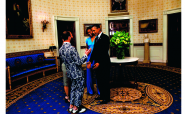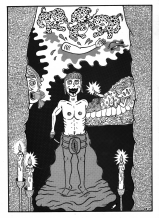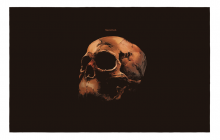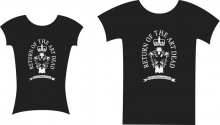|
The taxi driver drew our attention to an interesting contrast? on the one side of the street the glittering glass façade of the Hotel Intercontinental, where Arkan, Serbia’s notorious war criminal and mafia boss was gunned down in the hotel lobby in 2000, and opposite, squeezed between freeway overpass and train tracks, one of Belgrade’s biggest gypsy shantytowns, a sprawling mess of makeshift shacks and piled garbage with half naked gypsy children playing in the dirt among stray dogs. “Welcome to Belgrade,” said the taxi driver. It was my eighth time in Belgrade. I had come every summer ever since the end of the war, stayed for a while in the city before heading out into the countryside, to the Sumadija, to Kosovo, the Sandzak, Bosnia, Montenegro, Macedonia. This time I was here to cover the October Salon with William Hollister, an American editor at Umelec magazine. We knew very little about what was awaiting us. I had been told that this was the first October Salon where Kosovo Albanians were not represented. That at least was something to go with. We walked around Belgrade, the “Manhattan of the Balkans,” as they say. The buildings were grey and people stood on the pavement selling roast corn on the cob, ice cream, sun glasses and all manner of cheap wares. The cafes were full. Cars honked. The streets bustled. “You know what this place reminds me of?” said William. “A Tintin cartoon of Chicago.” There was something to be said for that. We were looking for a famous Belgrade restaurant. I asked a man on the street for directions. “Where do you come from?” he asked. “I’m American,” I said. “I’m from Kosovo,” the man said. “Mrzim Amerikanci.” I hate Americans. We met up with this year’s October Salon curator, the Hungarian critic Lorand Hegyi. At the former Turkish baths, one of the three venues for the October Salon, the empty swimming pool was strewn with rubbish assemblages by the Serbian artist Nenad Rackovic. In a small room hanging from the ceiling were Ivan Zupancs pictures of the golden cross of Belgrade’s new cathedral popping up in unusual angles with unlikely juxtapositions around town. Also interesting were Sarajevan Gordana Angelic Galic’s odd family photographs featuring hooded Ku Klux Klansmen and veiled Muslim women. egyi told me his concept for the October Salon. “Micro narratives” was his catchword. He spoke about the “absence of universal subjects,” and how in central and east Europe, and in particular in the Balkans, there was “an overdose of ideology and national fundamentalism,” where everything was “stylized like ideology, very aggressive and exclusivist.” This show was supposed to be “the apotheosis of non ideology, non monumentality, non hierarchy, a liberation from all that.” There was supposed to be a certain “ephemeral quality,” about the artwork presented in this year’s October Salon. “Broken beauty from old idea of beauty. Fragile. Ironic.” “Playful. Directly childish.” An art that declared: “I am not strong.” I put it to Hegyi that this declaration was at odds with Belgrade, a place that was marked by so much machismo, for Belgrade really is a very macho town and the streets are filled with strutting, beefy blokes, and the Serbian music, turbo folk, is all about presenting a larger than life posture while the graffiti on the walls pays homage to war heroes and Serbian myths. Where did Hegyi’s ”temptation of the small realities” have a place in all this” “For Belgrade it is more important,” said Hegyi, “because people are fed up with pseudo heroism...People here are more fragile, the macho attitude you come across here is a direct reaction of the last twenty years. If you speak more with people then you can sense their fragility. This macho attitude is on the surface. The majority of the people that I have spoken with are wounded and burned.” That evening we saw something that contrasted sharply to Hegyi’s concept of fragility, modesty and ephemerality. At the Center for Cultural Decontamination we saw a show entitled “Superego” by the Serbian artist living in Paris, Vuk Vidor, who also had work included in this year’s October Salon and which featured a life size statue of the artist giving the three fingered Serbian salute on a pedestal strewn with empty beer cans, while on one wall words in blinking lights proclaimed “No one like me,” pictures from the artist’s friends with the words “My friends are better artists than yours” were scrawled on the wall and photographs of glamorous looking people were presented with the statement, “My friends are better looking than yours.” This to me was a fair representation of the Serbian attitude, which stood in opposition to Hegyi’s intimate central European introversion and was all about striking a cocky, puffed-up, brazen pose. This was Serbian art. Something else that contrasted with Hegyi’s ideology of quiet modesty and introversion: the opening of the October Salon, which took place at the Tito museum. a magnificent socialist space with a grand Socialist Realist mosaic of soldiers and workers over the entrance, and Tito’s fully armored Rolls Royce in the foyer beside the stairs, a gift from the Queen of England, coincided with a roaring football match between Red Star Belgrade and Partizan, played at a stadium in the vicinity, with Heggi’s speech given on a podium on the steps of the museum, nearly drowned out by the chants of football fans. As for the show, there were plenty of art works that represented Hegyi’s ideas, a lot of infantile drawings representing weird, introverted teen-age worlds, but the Serbs stood out a bit. They were a bit brasher. There was Mrdan Bajic with his drawings on photographs for monumental sculptures to a dead country. Uros Djuric was also an odd choice. Djuric is well known in Serbia for his Constructivist pictures of soccer players, his rock stars and super heroes, a number of which were presented in a show at the New Moment gallery which coincided with the October Salon and which I had a chance to check out while I was in Belgrade, where I saw among the memorable works a picture of Tito clad in one of his typical military uniforms stroking a leopard. In all fairness to Hegyi’s concept, these Djuric works did not feature super heroes, but rather represented the artist posed with various celebrities such as Iggy Pop, Grace Jones and Wim Wenders. There were also a number of works by Vuk Vidor, whose show I had seen the day before, but in contrast to his latest show, was represented here with paintings and drawings of skulls.Vuk later showed up at the Tito Museum and I had a chance to speak with him. He admitted that the main tendency was the exact opposite of Hegyi’s concept. He gave me a catalogue of a Paris show, which included among other things a collage of Serbian paramilitary soldiers and African child soldiers and Elvis, with Arkan in the center role, posed with his paramilitary unit and holding a baby tiger by the scruff of the neck. Surrounded by these works of intimacy and fragility and while Hegyi discoursed on his ideas of micro narratives to journalists Vuk and I spoke about Serbian art. “Here you have to hit it hard to get people’s attention,” said Vuk. “You have to blow up people. You have to be like the UNA bomber.” What would Hegyi say to that? I also spoke with one of the organizers, Mihail Milunovic, and asked him about what he had to say about the curious fact that Kosovo Albanians were not included in the show. “It’s not a political issue,” said Mihail. “But you know, it’s not a one way story. The Kosovo Albanian artist started their careers in Belgrade; but these people don’t invite young artists from Serbia. They don’t want to receive a hand grenade through the window. Albanians from Kosovo say they can’t exhibit in Belgrade because they would be dead. If there is any prejudice it should be resolved on both sides.” As for the rest of our stay in Belgrade, we went out in the evenings, we went out in search of turbo folk, tried to crash a wedding on a boat on the Danube, ended up at Skadarlja, watching a tamburshi band serenade feasting Serbs with gypsy tunes, met a couple of Serbs who invited as to a folk club in a deserted corner of Novi Belgrade. The next day William left for Prague and I took a bus to a village in the Vojvodina in search of folk art. Mihail had told me about this village where all the inhabitants were naïve painters and people came from as far away as Japan to buy their art. It took me several hours to get there. Walking through the streets of this village, I found nothing that would suggest that this was a place famous for its art. I went to a bar and ordered a beer. I asked the waitress if she knew where I could see some naïve art. As it turned out her best friend’s grandmother was a naïve painter. She called her friend, who showed up shortly and took me to visit her grandmother, who lived in a small house the inside of which looked like something out the woodcuts of the Czech artist Josef Lada. The walls were hung with the grandmother’s paintings. They were all extremely kitschy, featuring rosy cheeked children and peasants frolicking in the countryside and looked like Christmas cards. The grandmother was Slovakian. All the people in this village were Slovak. They had come here in 1802 seeking religious freedom within the Austro -Hungarian empire, and they still spoke Slovak to this day. After visiting the grandmother we went to see the son, who was also an artist and who painted semi abstract still lives. We spoke in Serbian and drank home made slivovic and then it was time to head back to Belgrade. The next day I went around with Uros Djuric, hanging out at an art bar called Centrala, where I met the owner, an artist who made wild collages with images from the thirties and comic book superheroes. He introduced me to the video artist Milica Tomic, We spoke about turbo folk. It was the real expression of Serbian culture, said Milica. She herself had worked with a turbo folk star in one of her videos and she was now considering doing a turbo folk opera. “We Serbs, we feel it as just ours,” said Milica about turbo folk. "It is the most authentic product of Serbia.”The next day I flew back to Prague and from there went to Berlin. It had been an interesting couple of days in Belgrade. Lorand Hegyi’s notions of micro narratives and new intimacy made little impact on the White City. I remembered mainly the things around the periphery; the things which stood in contrast to Hegyi’s ideas, but most of all the thing that impressed me the most was the city of Belgrade. When would I see it again?
Рекомендуемые статьи

|
|
An American poet was invited to the White House in order to read his controversial plagiarized poetry. All tricked out and ready to do it his way, he comes to the “scandalous” realization that nothing bothers anyone anymore, and instead of banging your head against the wall it is better to build you own walls or at least little fences.
|

|
|
There’s 130 kilos of fat, muscles, brain & raw power on the Serbian contemporary art scene, all molded together into a 175-cm tall, 44-year-old body. It’s owner is known by a countless number of different names, including Bamboo, Mexican, Groom, Big Pain in the Ass, but most of all he’s known as MICROBE!… Hero of the losers, fighter for the rights of the dispossessed, folk artist, entertainer…
|

|
|
Contents of the new issue.
|

|
|
“A person must shake someone’s hand three times while gazing intently into their eyes. That’s the key to memorizing their name with certainty. It is in this way that I’ve remembered the names of 5,000 people who have been to the Horse Hospital,” Jim Hollands told me. Hollands is an experimental filmmaker, musician and curator. In his childhood, he suffered through tough social situations and…
|
|




































 We Are Rising National Gallery For You! Go to Kyjov by Krásná Lípa no.37.
We Are Rising National Gallery For You! Go to Kyjov by Krásná Lípa no.37.
Комментарии
Статья не была прокомментированаДобавить новый комментарий